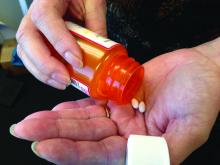Patients are more likely to report muscle-related adverse events (AEs) with statin therapy if a trial is unblinded, according to an analysis of a large clinical trial.
In the lipid-lowering arm of the Anglo-Scandinavian Cardiac Outcomes trial (ASCOT-LLA), 10,180 patients were randomized 1:1 to atorvastatin 10 mg daily or matching placebo for a median for 3.3 years. After the trial was terminated for efficacy, all patients were offered open-label atorvastatin, with 6,409 users and 3,490 nonusers then followed for a median of 2.3 years.
During the blinded phase, researchers saw similar rates of muscle-related adverse events in the intervention and placebo arm (2% vs. 2.03% per annum; HR, 1.03; P = .72), as well as similar rates of erectile dysfunction (HR, 0.88; P = .13).However, during the nonblinded, nonrandomized phase, the rate of muscle-related adverse events was 41% higher in individuals taking atorvastatin, compared with nonusers (1.26% vs. 1% per annum, P = .006). This was despite the fact that patients who reported muscle-related adverse events during the blinded phase were less likely to remain on a statin during the nonblinded phase, compared with those who had not reported this adverse event (Lancet. 2017 May 2. doi: 10.1016/S0140-6736[17]31075-9).
“This observation is consistent with a nocebo effect, whereby subjective AEs (e.g., symptoms reported by patients) can be more likely to be attributed to a treatment thought to cause some particular side effect,” wrote Ajay Gupta, MD, of the National Heart and Lung Institute at Imperial College London and his coauthors.
Musculoskeletal and connective tissue disorders and blood and lymphatic system disorders were also reported more commonly among those taking statins, compared with those not in the nonblinded phase. Apart from these, there were no other significant differences in the rate of other adverse events.
In the blinded phase, patients taking atorvastatin reported significantly lower rates of sleep disturbance, compared with those on placebo, but there was a significant 23% higher rate of renal and urinary adverse events in the atorvastatin arm, compared with the placebo arm. Researchers were not able to draw any conclusions about the incidence of cognitive impairment because there were too few cases.
“We hope that the demonstration in the ASCOT-LLA, of not only the absence of adverse effects of statin therapy on muscle-related and other AEs but also the effect of ascertainment bias in nonblinding studies (which have been the basis of many of the misleading claims), will help to counter the adverse effect on public health of exaggerated claims about statin side effects,” the authors wrote.
The study was funded by Pfizer, Servier Research Group, and Leo Laboratories. Four authors declared personal fees, funding, or speakers honoraria from pharmaceutical companies, including Pfizer. One author was also noted for having sought retraction of papers published about the side-effects of statin therapy. No other conflicts of interest were declared.


